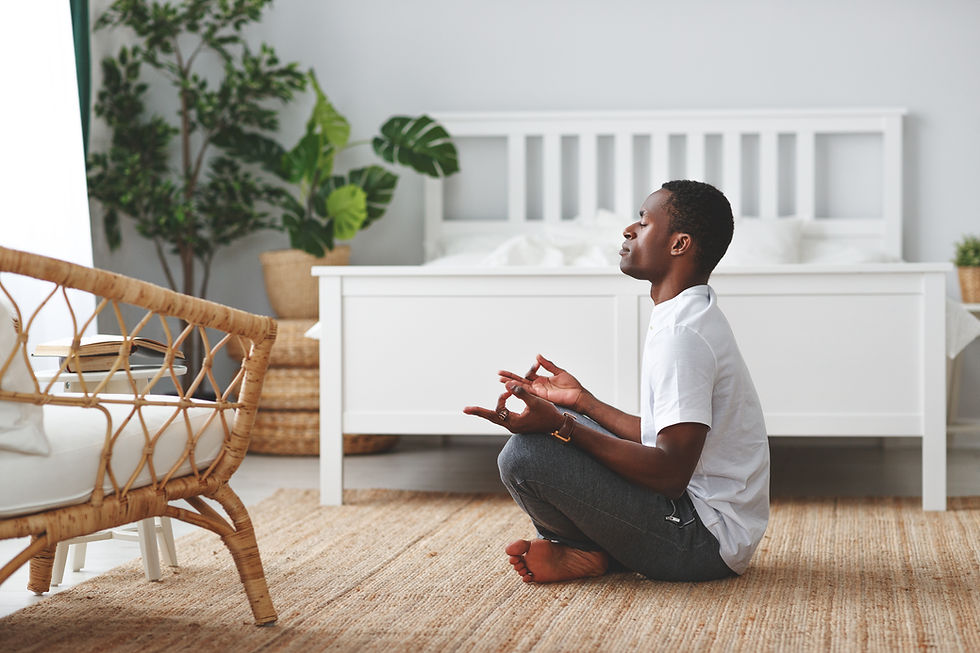How to Create a Meditation Space: Your Sanctuary for Mindfulness
- Manta

- Sep 15, 2024
- 4 min read
Updated: Sep 18, 2024

A personal meditation area allows you to cultivate a sense of peace and tranquility, making it easier to slip into mindfulness. Whether you have an entire room to dedicate or just a small corner in your home, creating a meditation space is all about intention and personalization. Here’s how to transform any area into your perfect sanctuary for mindfulness.
1. Choose the Right Location
The first step in creating your meditation space is selecting a location that fosters calmness and focus. Consider the following tips:
Quietness: Opt for a place that is away from the hustle and bustle of daily life. A quiet corner of a room, a spare bedroom, or even a balcony can work well.
Natural Light: If possible, choose a spot that receives natural light. Sunlight can boost your mood and create a warm and inviting atmosphere.
Accessibility: Make sure it’s easy to get to your meditation space. You’ll be more likely to practice if the space feels readily available and accessible.
2. Declutter and Simplify
To cultivate a peaceful atmosphere, declutter your chosen area. A clean space promotes clarity of mind. Here’s how to simplify your meditation space:
Remove Distractions: Clear away anything that may serve as a distraction, such as electronic devices or paperwork.
Minimalist Approach: Use minimal décor, opting for a few key items that resonate with you. This might include a plant, a candle, or an inspirational quote.
Regular Maintenance: Make it a habit to periodically reassess your space and keep it tidy, ensuring it remains a tranquil refuge.
3. Choose Comfortable Seating
Having comfortable seating is essential for enjoying longer meditation sessions. Consider the following options:
Cushions or Pillows: A supportive meditation cushion or a stack of soft pillows can provide comfort while encouraging proper posture.
Yoga Mat: If you prefer sitting on the floor, a yoga mat can offer comfort and stability for various meditation positions.
Chairs: If sitting cross-legged on the floor isn’t comfortable for you, choose a comfortable chair that allows you to sit upright without strain.

4. Add Elements of Nature
Incorporating natural elements can enhance the serenity of your meditation space. Here are some ideas:
Plants: Greenery not only beautifies your space but also promotes a sense of calm and connection to nature. Choose easy-to-care-for plants like succulents or peace lilies.
Natural Materials: Incorporate materials like wood, stone, or bamboo to create an earthy and organic feel.
Water Features: If space allows, consider a small fountain or a bowl of water to create soothing sounds and promote relaxation.
5. Personalize with Meaningful Decor
Your meditation space should reflect your personality and beliefs. Personal touches can make the space feel more inviting and inspiring:
Art and Inspirational Quotes: Hang art pieces that inspire you or display quotes that resonate with your meditation practice.
Altar or Sacred Space: If you feel drawn to it, create a small altar with meaningful objects such as crystals, candles, or images that hold spiritual significance for you.
Textures and Colors: Choose colors and textures that evoke calmness. Soft, neutral colors like blues, greens, or whites can create a tranquil environment.
6. Incorporate Aromatherapy
Scent can significantly enhance your meditation experience. Consider integrating aromatherapy into your space:
Essential Oils: Use an essential oil diffuser with calming scents like lavender, sandalwood, or eucalyptus to create a relaxing ambiance.
Candles or Incense: Burn scented candles or incense to bring warmth and a pleasant aroma to your meditation space. Ensure proper ventilation for safety.
7. Create a Focused Ambiance
The atmosphere plays a crucial role in your ability to concentrate and relax. Consider these finishing touches:
Lighting: Use soft, warm lighting to create a comforting glow in your space. Consider dimmable lamps or string lights to add a touch of serenity.
Sound: Integrate calming sounds such as nature sounds, soft music, or guided meditation tracks. If you prefer silence, consider using noise-canceling headphones or earplugs to minimize distractions.
Blanket or Throw: Having a cozy blanket nearby can make your space more inviting and comfortable, especially during longer sessions.
Creating a meditation space tailored to your preferences can significantly enhance your mindfulness practice. Remember, it’s not about perfection; it’s about creating a sanctuary that resonates with you and supports your journey toward peace and awareness. As you design and customize your meditation space, keep in mind that consistency and comfort are crucial.
Once your meditation space is set up, take time to enjoy it. Use your sanctuary regularly, allowing it to become a cherished part of your daily routine. The more time you spend in your dedicated space, the more it will become a refuge for your mind, body, and spirit.
Have you created a meditation space in your home? Share your tips and experiences in the comments below! If you found this guide helpful, don’t forget to subscribe for more insights on mindfulness, wellness, and personal growth.




Comments